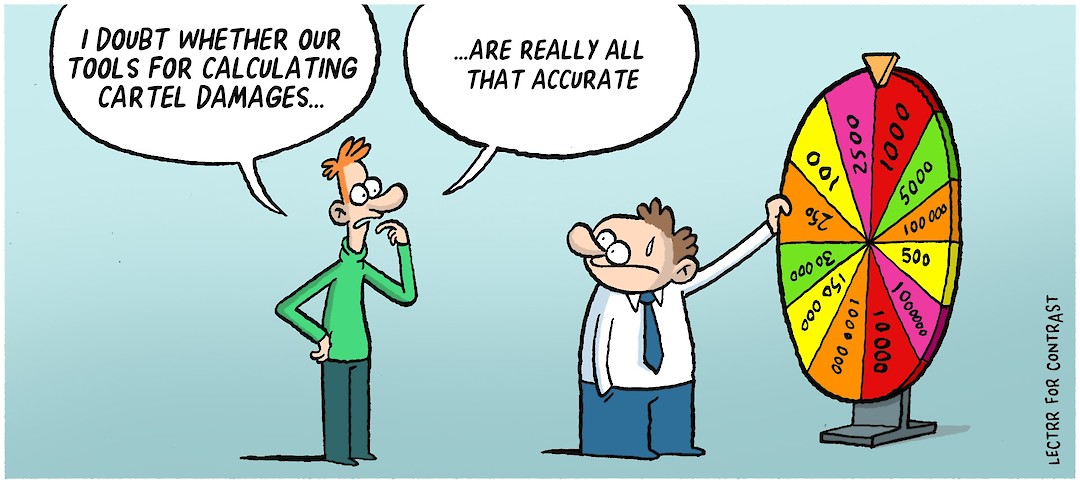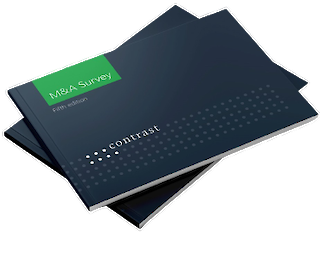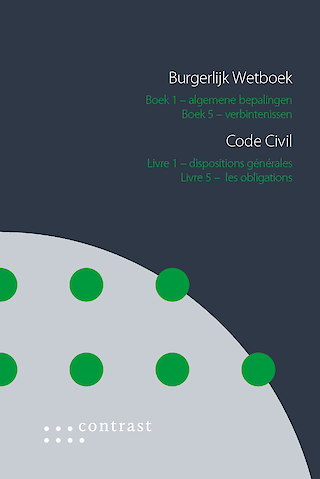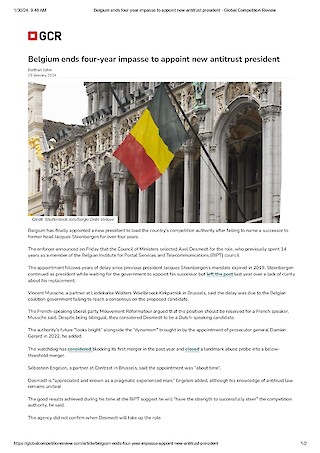In the Picture

How much were my cartel damages, again?
June 2019Imagine…
You are a distributor of solar panels. One morning you read in the newspaper that the European Commission imposes a stiff fine on the members of a solar panels cartel. And one of those members just happens to be your supplier, who is mentioned by name as being one of the cartel’s initiators.
This is bad news for your company’s reputation. Not only do you fear a drop in sales, but on top of that you undoubtedly paid too much to your supplier while the cartel was in effect. The newspaper says that it had been operating for over 7 years!
You do not want to just leave it at that, so you contact a lawyer to explore the possibilities of getting compensation for your damage. However, he immediately throws a bucket of cold water on you, saying that you’d be embarking on a long and arduous journey and, at the end of it, you might never see a euro.
You are dumbfounded. Why “long and arduous”? Why “maybe not a single euro”? Isn't it clear that you suffered harm and that it has to be compensated?
To clarify.
Victims of competition law infringements are entitled to full compensation of their harm. For this they must - like any party demanding compensation - prove that there has been an infringement, that it caused them harm, and that a causal link exists between the infringement and said harm.
Moreover, victims of competition law infringements would appear to have a key advantage, since the EU Private Damages Directive, which in the meantime has been transposed into the national law of the EU Member States, creates a presumption that a cartel infringement has caused damage. The victim of a cartel infringement, such as our solar panels distributor, can thus focus entirely on his damage estimate.
In practice, however, this estimate will be anything but easy. After all, how do you calculate the difference between your current situation and what your situation would have been if the cartel never existed? Is the higher price that you paid (the “overcharge”) exclusively attributable to the cartel, or were other factors in play? And what if you passed on the overcharge caused by the cartel to your customers?
As a first guideline for victims of competition law infringements, the European Commission published a communication and a practical guide for estimating the damage as well as a study of the passing-on of overcharges. Although these are not binding on the judge, they do constitute a good starting point for the damage estimate.
The damage estimate is generally done on the basis of one of the following three economic methods: the “before and after” method, the method of comparable product or comparable geographical market, or a combination of the two. The first method compares the prices of solar panels prior to the cartel with the prices while the cartel existed. The second method compares the prices of solar panels during the infringement period with prices in a comparable product or geographic market where no such infringement took place. The third method is a combination with a comparison over time and between markets.
Often the parties will have to call on professional economists in order to apply these methods in practice. The plaintiff can do this - but so can the infringer, for example in order to conduct a “passing-on defence”, where the infringer tries to demonstrate that the plaintiff passed on the overcharge to his customers, and thus actually suffered no harm himself. Under the EU Private Damages Directive, it is indeed the infringer who bears the burden of proving this.
Ultimately it is the judge who will decide about the damage estimate. It is self-evident that the difficulty of estimating the damage also applies to judges: as a rule, judges are no better versed in economics than lawyers are. Thus, the parties must strive to present their damage estimate to the judge in clear and digestible language.
Under the EU Private Damages Directive, the judge also has a number of instruments for assessing the damage. The judge can ask the national competition authority for assistance in determining the damage amount. He can also order the production of documents that might be useful for determining that amount. Finally, he is authorised to equitably estimate the damage, if it is established that a plaintiff suffered harm, but it is practically impossible or excessively difficult to precisely estimate the harm suffered on the basis of the available evidence.
Concretely:
- Private enforcement of competition law is still in its infancy, above all with regard to the damage estimate.
- There exists a refutable legal presumption that a cartel causes harm. This presumption applies only to the existence of the harm, not to the amount thereof. The plaintiff must prove the amount of the damage.
- It is anything but easy to furnish this proof. The European Commission has published practical guidelines for a first introduction to estimating damage.
- Professional economists will often be called on. The objective is to present the economic analysis in a way that is understandable to the court.
- The judge can equitably estimate the damage if its existence has been established, but it cannot be estimated, or at least not with any degree of precision.
Learn more?
- The EU Private Damages Directive is Directive 2014/104/EU on certain rules governing actions for damages under national law for infringements of the competition law provisions of the Member States and of the European Union: https://eur-lex.europa.eu/legal-content/EN/TXT/PDF/?uri=CELEX:32014L0104&from=EN.
- Communication from the Commission on quantifying harm in actions for damages: https://eur-lex.europa.eu/legal-content/EN/TXT/PDF/?uri=CELEX:52013XC0613(04)&from=GA.
- Practical Guide for estimating the damage: http://ec.europa.eu/competition/antitrust/actionsdamages/quantification_guide_en.pdf.
- Study on the passing-on of overcharges: http://ec.europa.eu/competition/publications/reports/KD0216916ENN.pdf.











